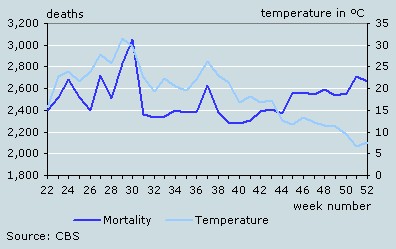Mild temperatures keep mortality down

With 135.5 thousand, last year’s mortality was again down on the preceding year, according to provisional data, published by Statistics Netherlands. In the period 2000-2003, mortality was approximately 5 thousand higher. The low mortality recorded since 2004 is remarkable, given the ageing of the population.
Seasonal mortality, 2000-2006

Mild autumn
The predominantly mild weather conditions in recent years contributed to the low mortality. Previous surveys indicate that extremely low as well as extremely high temperatures markedly push up mortality.
The autumn months of September, October and November were mild in 2006 compared to previous years. The mild temperatures were conducive to a low mortality rate. The number of autumn deaths was more than 2 thousand below the average in the period 2000-2003. The second week in September stood out: in that week temperatures were markedly above the long-term average and the mortality rate was considerably higher.
Weekly mortality, summer and autumn, 2006

Death toll lower as flu epidemic fails to materialise
The first two months of 2006 were relatively cold, but a flu epidemic failed to materialise. In the winter of 2005/2006, mortality was approximately 2 thousand down on the winter average of the period 2000-2003. In December 2006, mortality was more than 1 thousand below average.
Mortality in spring and summer was normal in the period 2000-2003. Spring temperatures varied around the long-term average. Summer temperatures were rather extravagant: temperatures in July were well above average, pushing up mortality. August, on the other hand, was relatively cool exerting a positive effect on mortality.
Mortality risk by season and age, 2000/2006 (annual average = 100)

Over-80s run highest risk in winter
The relation between temperature and mortality becomes stronger with advancing age. In winter, the risk of dying for over-80s is about 11 percent above the annual average. A relatively large number of older people die in winter from diseases of the respiratory system and cardiovascular diseases.
Joop Garssen and Carel Harmsen